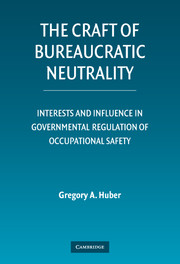 The Craft of Bureaucratic Neutrality
The Craft of Bureaucratic Neutrality 2 - Political Conflict and the Occupational Safety and Health Act
Published online by Cambridge University Press: 27 July 2009
Summary
The primary empirical focus of this book is federal and state enforcement of the Occupational Safety and Health Act of 1970 (OSH Act). The OSH Act sets out as its purpose “[t]o assure safe and healthful working conditions for working men and women,” and to attain this goal it authorizes the promulgation and enforcement of rules for employers governing working conditions. The enforcement of these rules is the shared responsibility of a federal agency, the Occupational Safety and Health Administration (OSHA), and the states. After introducing this case, this chapter tests the claim that bureaucratic leaders can often respond to both external political pressure and the need to control their subordinates by adopting a “strategically neutral” enforcement posture. This examination therefore links this specific inquiry with my more general interest in assessing the theories of bureaucratic power and decision making introduced in the previous chapter.
OSHA's embrace of strategic neutrality has allowed the agency's leaders to direct policy, to a substantial degree, toward their own ends despite opposition to aggressive government regulation of working conditions. By systemically discriminating among businesses based on their size, safety history, and industry of operation, OSHA has demobilized specific components of the business lobby, particularly small businesses in safe industries, that would otherwise incline politicians to act against the agency. At the same time, by persistently enforcing the law neutrally across geographic areas and individual firms, OSHA has assured supporters that it is necessary and effective.
- Type
- Chapter
- Information
- The Craft of Bureaucratic NeutralityInterests and Influence in Governmental Regulation of Occupational Safety, pp. 47 - 94Publisher: Cambridge University PressPrint publication year: 2007
